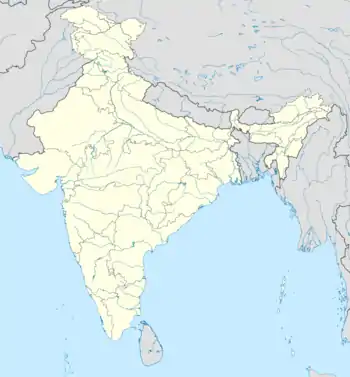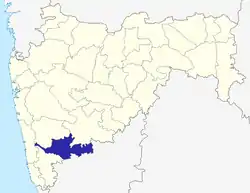Sangli
Sangli (![]() pronunciation , is a city and the district headquarters of Sangli District in the state of Maharashtra, in western India. It is known as the Turmeric City of Maharashtra due to its production and trade of the spice.[5] Sangli is situated on the banks of river Krishna and houses many sugar factories.
Sangli is a major city in Western India 390 km from Mumbai, 240 km (150 mi) from Pune and 700 km (430 mi) from Bangalore. Sangli is known for its turmeric trade, grapes and the largest number of sugar factories in India. The only district has more than 30 sugar factories. Sangli Miraj Kupwad, along with its Urban Agglomeration together known as Sangli Miraj Kupwad Metropolitan Region (SMKMR).
pronunciation , is a city and the district headquarters of Sangli District in the state of Maharashtra, in western India. It is known as the Turmeric City of Maharashtra due to its production and trade of the spice.[5] Sangli is situated on the banks of river Krishna and houses many sugar factories.
Sangli is a major city in Western India 390 km from Mumbai, 240 km (150 mi) from Pune and 700 km (430 mi) from Bangalore. Sangli is known for its turmeric trade, grapes and the largest number of sugar factories in India. The only district has more than 30 sugar factories. Sangli Miraj Kupwad, along with its Urban Agglomeration together known as Sangli Miraj Kupwad Metropolitan Region (SMKMR).
Sangli | |
|---|---|
 Sangli  Sangli | |
| Coordinates: 16.853°N 74.583°E | |
| Country | |
| State | Maharashtra |
| District | Sangli |
| Founded by | Harbhat Patwardhan |
| Government | |
| • Type | Municipal Corporation |
| • Body | Sangali-Miraj-Kupwad Municipal Corporation (SMKMC) |
| • Mayor | Geeta Sutar (BJP) |
| • Deputy Mayor | Ananda Devmane (BJP) |
| • Municipal commissioner | Nitin Kapadnis [1] |
| • Member of Parliament | Sanjaykaka Patil (Lok Sabha)[2] |
| Area | |
| • Total | 118.18 km2 (45.63 sq mi) |
| Elevation | 549 m (1,801 ft) |
| Demonym(s) | Sanglikar |
| Languages | |
| • Official | Marathi |
| Time zone | UTC+5:30 (IST) |
| PIN | 416416[4] |
| Telephone code | +91-233 |
| Vehicle registration | MH-10 |
| Literacy | 85.93% |
| Lok Sabha constituency | Sangli (Lok Sabha constituency) |
| Climate | Dry and Arid (Köppen) |
| Website | sangli |

Sangli UA/Metropolitan Region has developed itself as now as a modern city with broader roads, major railway junction, cyber-cafes, hotels with multi-cuisine and very good education facilities. The city has a major healthcare hub including its twin City Miraj. It is also a major city with telecommunication and entertainment facilities. A Software Technology Park is being set up in a prime location of the city.
Geography
Sangli city is situated on the bank of Krishna river, the valley and tributaries of which offer many irrigation and agricultural advantages that drive the economy of the district and the city. Other small rivers, such as the Warana and the Panchganga, flow into the River Krishna.
History
The region, known as Kundal (now a small village 40 km away from Sangli city) in medieval India, was the capital of the Chalukya Empire in the 12th century AD.[6] During the time of Shivaji, Sangli, Miraj and surrounding areas were captured from the Mughal Empire. Until 1801, Sangli was included in Miraj Jahagir. Sangli separated from Miraj in 1801, following a family quarrel between Chintamanrao Patwardhan, and his paternal uncle, Gangadharrao Patwardhan, who had succeeded his childless elder brother as the sixth chief of Miraj in 1782.
Sangli is notable for the Brindavana (tomb) of Satyavrata Tirtha, a saint of Dvaita Order of Vedanta and Peetadipathi of Uttaradi Math who took Samadhi in Sangli in the year 1638.
Etymology
The city's original name was Sahagalli—from the Marathi words saha ("six") and galli ("lanes") describing the early street plan—which was later shortened to Sangli.[7]
Governance
The Sangli-Miraj-Kupwad Municipal Corporation (S.M.K.M.C.) is the local self-government body which looks after the development of the Sangli-Miraj twin cities, serving 0.5 million citizens.
Educational institutes
Education institutions in the area, aside from schools, include engineering colleges such as Walchand College of Engineering RIT college Sakhrale, Islampur, Padmabhooshan Vasantraodada Patil Institute of Technology, KBP College, and Annasaheb Dange College of Engineering & Technology. Government Medical College, Miraj, is also present, as is the Willingdon College of Arts & Science at Vishrambaug. Prakash Institute of Medical Science and research Islampur Sangli, Bharathi Vidyapeeth - Sangli, Miraj. Appasaheb Birnale College of Architecture,South Shivaji Nagar,Sangli
Architecture
- Ganapati Temple, located on the banks of river Krishna.
- The Irwin Bridge, built by the British.
- A royal palace (Rajwada).
- Mai ghat, Bhilawadi.
Climate
| Sangli | ||||||||||||||||||||||||||||||||||||||||||||||||||||||||||||
|---|---|---|---|---|---|---|---|---|---|---|---|---|---|---|---|---|---|---|---|---|---|---|---|---|---|---|---|---|---|---|---|---|---|---|---|---|---|---|---|---|---|---|---|---|---|---|---|---|---|---|---|---|---|---|---|---|---|---|---|---|
| Climate chart (explanation) | ||||||||||||||||||||||||||||||||||||||||||||||||||||||||||||
| ||||||||||||||||||||||||||||||||||||||||||||||||||||||||||||
| ||||||||||||||||||||||||||||||||||||||||||||||||||||||||||||
Sangli has a semi-arid climate with three seasons, a hot, dry summer from the middle of February to the middle of June, a monsoon from the middle of June to late October and a mild cool season from early November to early February. The total rainfall is about 22 inches (580 mm). Sangli has a chill climate throughout winter; summers are dry but not as dry as in the larger metropolitan cities. Rain is within its limits.
| Climate data for Sangli | |||||||||||||
|---|---|---|---|---|---|---|---|---|---|---|---|---|---|
| Month | Jan | Feb | Mar | Apr | May | Jun | Jul | Aug | Sep | Oct | Nov | Dec | Year |
| Average high °C (°F) | 31 (88) |
33 (91) |
36 (97) |
38 (100) |
37 (99) |
31 (88) |
28 (82) |
28 (82) |
30 (86) |
32 (90) |
30 (86) |
30 (86) |
32 (90) |
| Average low °C (°F) | 09 (48) |
15 (59) |
18 (64) |
21 (70) |
22 (72) |
22 (72) |
21 (70) |
21 (70) |
20 (68) |
19 (66) |
11 (52) |
10 (50) |
17 (63) |
| Average precipitation mm (inches) | 3.8 (0.15) |
0.5 (0.02) |
5.3 (0.21) |
22.1 (0.87) |
48.3 (1.90) |
71.1 (2.80) |
108.7 (4.28) |
79.8 (3.14) |
99.6 (3.92) |
88.9 (3.50) |
33.5 (1.32) |
6.9 (0.27) |
568.5 (22.38) |
| Source: Government of Maharashtra | |||||||||||||
References
- महापालिका आयुक्तपदी नितीन कापडनीस | पुढारी [Nitin Kapadnis as Municipal Commissioner | Leader]. www.pudhari.news.
- "Sixteenth Lok Sabha Members Bioprofile". Retrieved 21 October 2019.
- Sangli Municipal Corporation
- "Archived copy". Archived from the original on 6 September 2013. Retrieved 4 January 2013.CS1 maint: archived copy as title (link)
- Benzie, F. F.; Sissi Wachtel-Galo (2011). "13: Turmeric, The Golden Spice: From Traditional Medicine to Modern Medicine". In F. F. Benzie (ed.). Herbal Medicine: Biomolecular and Clinical Aspects (Second ed.). Boca Raton, FL 33487-2742, USA: CRC Press Taylor and Francis Group. p. 269. ISBN 978-1-4398-0713-2.CS1 maint: location (link)
- http://shodhganga.inflibnet.ac.in/bitstream/10603/8595/2/11%20topic%20no.3.pdf
- http://www.britannica.com/EBchecked/topic/522386/Sangli
